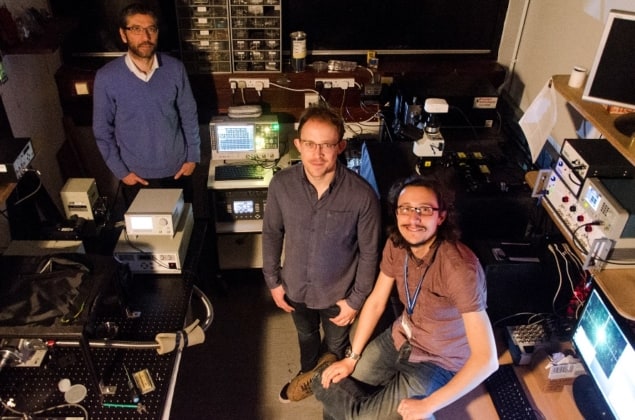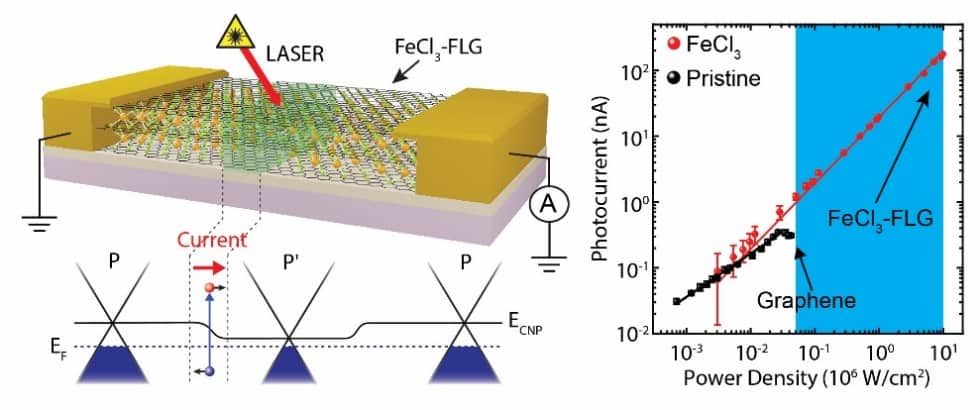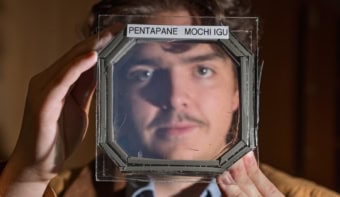
With our persistent march towards nuclear fusion, the need for technologies that can operate in high-energy environments is becoming ever more urgent. Now, researchers in the UK and Spain have discovered a material that can allow us to take pictures inside a nuclear reactor.
In the past, graphene has been used in the design of flexible photodetectors that operate over a large range of frequencies. However, compared to current inorganic photodetectors, the resolution and power response just do not measure up.
Chemical doping of graphene can help some of these problems by increasing the density of charge carriers (electrons or holes). Adding iron-chloride (FeCl3) molecules between a few layers of graphene has been shown to lead to extremely high concentrations of carriers in the material. This FeCl3-intercalated few-layer graphene (FLG) is also stable in ambient conditions. It is 1000 times more conductive than pure single-layer graphene, while retaining an equally low absorption in the visible frequency range.
Starting with this material as a base, Saverio Russo and his group at the University of Exeter, UK, used a laser to engrave regions of lower carrier concentration. The laser removes some of the FeCl3 molecules, creating photoactive junctions between highly doped and laser-treated regions of the material. When light shines on this junction, a current is detected across the material, like in a pixel in a camera sensor.
The recipe for extreme photodetectors
The cleverness of this particular material lies in the ultra-high carrier concentration and accelerated cooling of the carriers. Unlike in previously studied devices, the response of the carriers is purely photovoltaic. In FeCl3-intercalated FLG, when the carriers are generated by the incident photons, the electric field created by the difference in charge density on either side of the junction leads to a separation of electrons and holes. This in turn leads to a current.

In other graphene-based photodetectors the carrier behaviour is dominated by the photothermoelectric (PTE) effect; the difference in Seebeck coefficients either side of the junction is responsible for the diffusion of hot carriers when illuminated, as in a common thermocouple. This means the response is spread across an area of a few μm, which limits the size and packing density of the pixels. Using FeCl3-intercalated FLG instead has a huge advantage here, as the miniaturization of pixels is not hindered by a need for thermal isolation.
“This is truly a wonder material; our results show for the first time that graphene-based photodetectors are not always dominated by the PTE,” says Adolfo De Sanctis, lead author of the paper. A reduction of the PTE effect, in fact, results in another marvel. Pixels made from FeCl3-intercalated FLG have a linear (and therefore predictable and reliable) response to photons over a range of incident powers that reaches around 4500 times higher than for other graphene-based devices. This huge linear dynamic range holds true for frequencies from mid-IR to UV-A. This makes these pixels ideal for extreme environments, such as within nuclear reactors, or for working with the high-energy lasers needed for nuclear fusion.
Breaking the diffraction limit
In the absence of the PTE effect, the size of the junctions is instead constrained by the diffraction limit of the laser used to create them. In collaboration with a team at the Institut de Ciències Fotòniques (ICFO), Spain, led by Frank Koppens, the researchers pushed beyond the limits of diffraction when creating the junctions. Using near-field optical nanoscopy, they were able to carve away the FeCl3 molecules and create a junction with a width of only 250 nm, more than halving the diffraction limit of the laser.
The next challenge that faces the researchers lies in producing larger sheets of this exciting material. They can then pattern extensive arrays of photoactive junctions, creating an imaging device suitable for the extreme environments that modern research is leading us towards.
You can read more about this work in the original paper, published in Science Advances.



